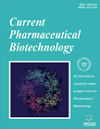-
oa Editorial [Hot Topic: Novel Pharmacotherapies for Diabetic Retinopathy: Current and Future Perspectives (Guest Editor: V.S. Jeganathan)]
- Source: Current Pharmaceutical Biotechnology, Volume 12, Issue 3, Mar 2011, p. 336 - 336
-
- 01 Mar 2011
- Previous Article
- Table of Contents
- Next Article
Abstract
Diabetic retinopathy (DR) remains one of the most serious and visually disabling complications of diabetes, particularly among working-age individuals in developed countries [1]. By 2030, approximately 366 million people are expected to have been affected by diabetes [2]. DR is not only a major cause of preventable blindness, but also accounts for a significant portion of the morbidity and mortality. At present, primary prevention occurs by improving metabolic control using intensive glycemic regulation, strict blood pressure control, and lipid modifying treatment. Standard therapy for DR includes panretinal photocoagulation (PRP) and vitrectomy—both invasive procedures that have considerable adverse effects. Considerable progress has been made in the delivery of ophthalmological care for DR over the past decade. Various adjunctive pharmacological therapies, including anti-vascular endothelial growth factor agents, have shown early promise in the treatment of DR. Intravitreal triamcinolone has been proven to have short-term beneficial effects in the treatment of DR and may be a useful adjunct in certain patients undergoing treatment with PRP. Intravitreal injection of the autologous plasmin enzyme is a safe and effective adjunct to vitreous surgery for the treatment of both DME and proliferative DR. The fluocinolone acetonide implantable device has shown medium-term efficacy against DME in several trials, despite the absence of U.S. FDA approval for its use to treat DR [3]. Intraocular drug delivery systems' sustained-release agents maximize drug efficacy while limiting the risk of systemic side effects. Currently clinical experiences for DR with non-biodegradable implants such as Retisert and Illuvien, which have longer periods of drug release compared to biodegradable implants and provide high local drug concentrations, continue to increase. Interest in the role of aldose reductase (AR), the first enzyme of the sorbitol pathway of glucose metabolism, has been renewed by recent clinical evidence linking the progression of retinopathy with the presence of AR activity [4]. Novel potent AR inhibitors that have recently become available, such as ranirestat and fidarestat, are of particular interest. Furthermore several protein kinase C (PKC) inhibitors such as Ruboxistaurin have been successful in reducing visual loss in patients with DR (in the PKC DRS2 trial). Therapies preventing superoxide accumulation are currently being developed, targeting multiple steps of oxidative stress and mitochondrial damage in diabetes. Pigment epithelium-derived factor (PEDF) has been discovered to be an endogenous anti-inflammatory and anti-oxidative agent that protects the progression of proliferative DR [5]. In summary, we live in exciting times, with various novel pharmacological agents in the process of being evaluated for the treatment of DR as well as DME in multicentre randomized clinical trials. As prospective randomized clinical trials accumulate data, the role of pharmacologic treatments will become clearer. More definitive studies on these therapies, elucidating their role alone or in combination, are warranted. Long-term safety and efficacy need to be clarified as well.


